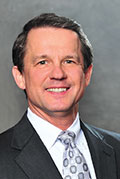December 2018, Vol. 245, No. 12
Features
PPI President Discusses Growth, Challenges of Plastic Pipe Industry

Tony Radoszewski, CAE, is president of the Dallas-based Plastics Pipe Institute, a major North American plastic pipe trade association representing all segments of the plastic pipe industry, including producers of resins, pipe, fittings, and components.
A veteran of the plastics industry, Radoszewski’s 35 years of experience includes leadership positions in sales, marketing and business development at Phillips 66 Company/Phillips Driscopipe, now part of the Performance Pipe Division of Chevron Phillips. He also served as director of marketing and business development for Advanced Drainage Systems. Radoszewski earned a bachelor’s degree in chemistry from St. Mary’s University in San Antonio.
P&GJ: How is demand for plastic pipe in the oil and gas industry compared to five years ago?
Radoszewski: The oil and gas industry is notorious for its boom and bust cycles. Coming out of the “Great Recession” that hit its nadir in 2009, our industry saw a quick turnaround in 2010 and then hit record sales during the next four years due mainly to the significant strength of the oil patch. When the price of oil collapsed in November of 2014, we saw an immediate impact on sales with a decrease of 40% in 2015 and another 27% percent decrease in 2016. Then, like turning on a dime, sales took off in March of 2017 and we ended the year up 86% over 2016, and through this September we are already ahead of all 2017.
Such an increase in demand has put a severe constraint on our ability to supply, causing long lead times and an increase in imports from Mexico, China, South America and the Middle East. There has also been a lot of interest in new companies opening in the Permian Basin to serve the high demand.
P&GJ: Is membership in PPI growing? What geographic regions have shown the most growth?
Radoszewski: Overall membership is growing, not only in energy but in every market where pipe is used, including municipal water and sewer, power and communications, stormwater drainage along with building and construction.
The growing acceptance of plastics as an alternative to legacy materials, namely concrete and metals, has meant plant expansions and new companies, some foreign based, to begin operations here in the U.S. The greatest regions for continued growth will be in the Southeast, specifically Florida, and in Texas. In the case of Texas, this is certainly due to the high demand in the oil patch as mentioned earlier, but also because the population of the state is growing significantly, as well.
P&GJ: What do PPI members see as their biggest concerns going forward?
Radoszewski: Like so many manufacturing industries, a shortage in skilled labor is an ongoing challenge. Couple that with the onset of Baby Boomers retiring, the loss of industry knowledge is also of concern. Many of our members are actively developing younger workers and the demand for educational tools from our association is growing dramatically.
P&GJ: Are there any pending regulatory concerns on the organization’s radar?
Radoszewski: As with any industry, we see good regulations and not-so-good regulations. We support authorizing the Federal Energy Regulatory Commission (FERC) as the lead entity for pipeline permits and support their expediting the process. With the opening of federally owned lands to exploration and production of oil and gas, we also support policy that accelerates permitting and right-of-way approvals needed to do so.
However, one we do not support is the final rule (2014-30336) by the Pipeline and Hazardous Materials Safety Administration (PHMSA) that eliminated the use of re-work materials in regulated PE gas pipe production. Based on current use, this regulation could cost local distribution companies and PE pipe manufacturers more than $55 million over ten years. The most telling aspect of this rule is that it was based upon regulator “opinion” and not science. The use of rework materials during the past 40 years has not been identified as the cause of any field failures.
P&GJ: Is PPI’s leadership looking to institute any changes going in the near term?
Radoszewski: We have come to realize that the government is getting more and more involved in so many facets of our industry. As a result, we must be engaged in government advocacy and education in all the markets we serve, not only the energy field. As a result, we are restructuring our organization to better address these issues and focus more at the state and federal level when it comes to legislation or oversight from both a staffing and membership perspective. Just a sign of the times. P&GJ





Comments